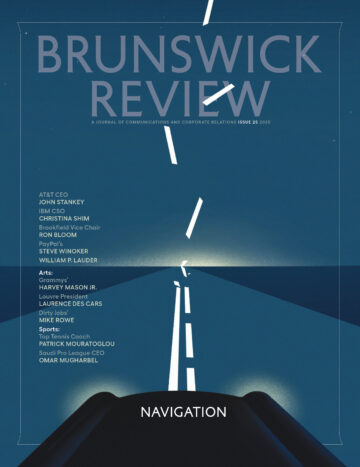The way people access information on the internet is fundamentally changing. Large language models like OpenAI’s ChatGPT, Google’s Gemini and Anthropic’s Perplexity offer users what they need without visiting a single website. They are becoming influential intermediaries because they not only provide information but also frame answers to questions posed within a narrative.
For many audiences, these models now deliver the first—and sometimes only—impression of your company. Research by Bain & Company shows that these “zero-click” results constitute nearly 60% of search activity. Even people who dig deeper are doing so after their expectations have already been shaped by what AI told them.
Welcome to the era of algorithmic relations. It’s not a replacement for media relations or stakeholder engagement, but an evolution of them. The fundamentals still apply: understand the landscape, engage key voices, treat it as a long game. But companies now need to factor in not only how their messages will land with key human audiences, but how they’re interpreted and reassembled by machines.
You can easily test this phenomenon yourself. Ask some of the most popular AI tools to summarize your business. What’s it known for? How does it treat employees? What is its stance on ESG? Who runs it? The answers will be delivered with confidence—and often, with surprising inconsistencies or gaps.
Brunswick developed an AI-powered tool to analyze how companies show up in these generative platforms. Two findings in particular stood out from that research.
The first: AI rewards substance. The models prioritize specific, verifiable content: facts, figures, commitments or concrete achievements are more inclined to be mentioned in its answers.
If your website content is outdated, AI will still repeat it. If it is buried or hard to parse, AI will look elsewhere.
The second finding is that, at least for the time being, these large language models often appear to weight sources in ways that mirror the logic of Google’s search algorithm—favoring structured, high-authority, widely cited content.
Both of these points highlight how important it is that companies establish themselves as trusted sources for their own information. And our analysis has found that they are falling down on that score. Companies regularly fail to answer the most common questions people ask about them—in some instances, companies answered as few as 10% to 20% of the most commonly asked questions correctly or completely enough to satisfy the question.
Take CEO biographies, for instance. Across industries, the public generally wants to know where the CEO studied, their career history, compensation and a few personal details. The list of regularly asked questions numbers about 10. Yet most corporate sites provide only a few of those answers, and those are often buried.
The AI’s goal is to satisfy the user. If it can’t generate answers from data on the company website, it looks for it elsewhere, filling in the gaps from wherever it can: SEO-driven publishers, content farms, outdated bios, niche publications—even, on occasion, making it up.
What Companies Can Do
- Treat Your Website Like It Matters
Even the engineers who build them admit that much of the process behind the answers that large language models provide remains a black box. What we do know is that these models draw from a vast and messy web of sources, each weighted and evaluated in different ways. And we know that one of the first places they go for company-specific information is the company’s own website.
That makes it critical for your site to be current, comprehensive and structured for machines as well as people. Use clear, direct language in formats that AI can easily process. Include invisible but essential elements like schema markup, which helps machines understand the meaning of your content, as well as structured metadata, which gives context to each page.
If your website content is outdated, AI will still repeat it. If it is buried or hard to parse, AI will look elsewhere. - Answer the Real Questions
Use SEO tools, search data and platform queries to understand what people are actually asking about your business. Then answer those questions directly on your site, in your bios and in your reports. Don’t assume positioning language is enough.
Companies have always been prone to talking to themselves—publishing the key messages they want to broadcast rather than addressing the questions their audiences actually want to know. Silence in an age of AI-generated summaries means someone else gets to define you, and algorithms will spread their version.
A little can go a long way. On sensitive issues involving workplace culture, for instance, we’ve seen that LLMs will often mention when a company acknowledges shortfalls and describe corrective measures leadership is taking. - Monitor the LLMs, Especially During Crises
Regularly test how you’re being described. Use different phrasing, across multiple platforms. Keep a record of inaccuracies, gaps or distortions.
This practice becomes even more important during a crisis—and even after it appears resolved. LLMs may continue surfacing outdated or misleading narratives after you’ve released a statement or addressed the issue in the press. The correction might exist, but that doesn’t guarantee AI systems will pick it up and weight it accordingly—and right now, there are few reliable ways to prompt them to do so. - Don’t Paint All LLMs with the Same Brush
Large language models vary, not just in how they are built but in what they are allowed to access. Some exclude major media outlets from their training data due to licensing restrictions. That means the high-profile story you worked hard to land may not show up in certain summaries.
This only raises the importance of publishing on your own website and pursuing coverage in sources these LLMs might be able to access, whether that is a trade publication, an industry blog or a well-indexed database. - Build AI-Literate Comms Teams
Your communications team should understand the basics of how AI systems parse, rank and synthesize content. What signals do they pick up? What formats do they favor? Where are they likely to go first?
We’ve already seen this play out in investor relations. When AI began analyzing earnings calls and transcripts, IR teams learned to adjust, making their content machine-readable, refining tone and structuring presentations for algorithmic parsing. That same mindset and discipline can be applied across all corporate content and communications. If AI-powered tools are the new first stop for stakeholders seeking answers, then companies need to account for that in every moment that matters.
More from this issue

Navigation
Most read from this issue

Future of AI in Healthcare






